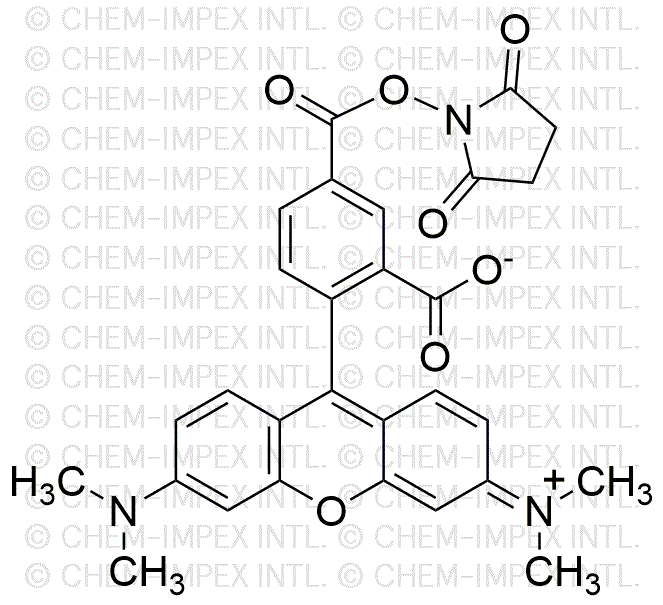5-Carboxy-tetramethylrhodamine N-succinimidyl ester is widely utilized in research focused on:
- Fluorescent Labeling: This compound is commonly used in biological research for labeling proteins and antibodies. Its bright fluorescence allows researchers to track and visualize cellular processes in real-time.
- Immunofluorescence Assays: It plays a crucial role in immunofluorescence techniques, enabling the detection of specific antigens in cells or tissue sections. This application is vital in diagnostics and research in fields like cancer and immunology.
- Flow Cytometry: The compound is utilized in flow cytometry to analyze cell populations. Its fluorescent properties help in distinguishing between different cell types based on their surface markers, facilitating advanced research in hematology and cell biology.
- In Vivo Imaging: Researchers use this chemical for in vivo imaging studies, where it aids in tracking biological processes within living organisms. This application is particularly beneficial in drug development and disease progression studies.
- Bioconjugation: It is effective for bioconjugation, where it links biomolecules to other entities like nanoparticles or drugs. This enhances the specificity and efficacy of therapeutic agents, making it a valuable tool in targeted drug delivery systems.
General Information
Properties
Safety and Regulations
Applications
5-Carboxy-tetramethylrhodamine N-succinimidyl ester is widely utilized in research focused on:
- Fluorescent Labeling: This compound is commonly used in biological research for labeling proteins and antibodies. Its bright fluorescence allows researchers to track and visualize cellular processes in real-time.
- Immunofluorescence Assays: It plays a crucial role in immunofluorescence techniques, enabling the detection of specific antigens in cells or tissue sections. This application is vital in diagnostics and research in fields like cancer and immunology.
- Flow Cytometry: The compound is utilized in flow cytometry to analyze cell populations. Its fluorescent properties help in distinguishing between different cell types based on their surface markers, facilitating advanced research in hematology and cell biology.
- In Vivo Imaging: Researchers use this chemical for in vivo imaging studies, where it aids in tracking biological processes within living organisms. This application is particularly beneficial in drug development and disease progression studies.
- Bioconjugation: It is effective for bioconjugation, where it links biomolecules to other entities like nanoparticles or drugs. This enhances the specificity and efficacy of therapeutic agents, making it a valuable tool in targeted drug delivery systems.
Documents
Safety Data Sheets (SDS)
The SDS provides comprehensive safety information on handling, storage, and disposal of the product.
Product Specification (PS)
The PS provides a comprehensive breakdown of the product’s properties, including chemical composition, physical state, purity, and storage requirements. It also details acceptable quality ranges and the product's intended applications.
Certificates of Analysis (COA)
Search for Certificates of Analysis (COA) by entering the products Lot Number. Lot and Batch Numbers can be found on a product’s label following the words ‘Lot’ or ‘Batch’.
*Catalog Number
*Lot Number
Certificates Of Origin (COO)
This COO confirms the country where the product was manufactured, and also details the materials and components used in it and whether it is derived from natural, synthetic, or other specific sources. This certificate may be required for customs, trade, and regulatory compliance.
*Catalog Number
*Lot Number
Safety Data Sheets (SDS)
The SDS provides comprehensive safety information on handling, storage, and disposal of the product.
DownloadProduct Specification (PS)
The PS provides a comprehensive breakdown of the product’s properties, including chemical composition, physical state, purity, and storage requirements. It also details acceptable quality ranges and the product's intended applications.
DownloadCertificates of Analysis (COA)
Search for Certificates of Analysis (COA) by entering the products Lot Number. Lot and Batch Numbers can be found on a product’s label following the words ‘Lot’ or ‘Batch’.
*Catalog Number
*Lot Number
Certificates Of Origin (COO)
This COO confirms the country where the product was manufactured, and also details the materials and components used in it and whether it is derived from natural, synthetic, or other specific sources. This certificate may be required for customs, trade, and regulatory compliance.


